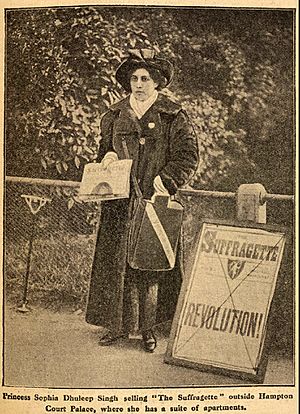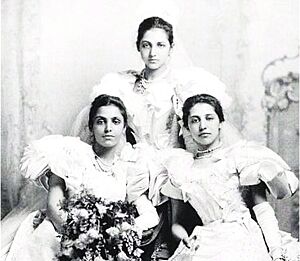Sophia Duleep Singh facts for kids
Quick facts for kids Sophia Duleep Singh |
|
|---|---|

Sophia Duleep Singh selling The Suffragette in 1913
|
|
| Born | 8 August 1876 Elveden Hall, Elveden, Suffolk, England |
| Died | 22 August 1948 (aged 72) Tylers Green, Buckinghamshire, England |
| Father | Maharaja Duleep Singh |
| Mother | Bamba Müller |
| Religion | Sikhism |
| Occupation | Prominent suffragette in the United Kingdom |
Princess Sophia Duleep Singh (born August 8, 1876 – died August 22, 1948) was an important leader for women's rights in the United Kingdom. Her father was Maharaja Duleep Singh, who was a king taken from his land in Punjab by the British. He was later sent to live in England. Sophia's mother was Bamba Müller, and her godmother was Queen Victoria.
Sophia lived in Hampton Court Palace in a special apartment given to her by Queen Victoria. In the early 1900s, Sophia was one of the first Indian women to fight for women's rights in Britain. She is best known for her main role in the Women's Tax Resistance League. This group protested by refusing to pay taxes. She also joined other groups that wanted women to have the right to vote, like the Women's Social and Political Union.
Contents
Sophia's Early Life
Sophia Duleep Singh was born on August 8, 1876, in Belgravia, England. She grew up in Suffolk. She was the third daughter of Maharaja Duleep Singh, who was the last ruler of the Sikh Empire. Her mother was Bamba Müller. Sophia's mother had a German father and an Ethiopian mother.
Sophia's family had a mix of Indian, European, and African roots. She was named Sophia after her grandmother, who was from Ethiopia. Her middle name, Alexandrovna, honored her godmother, Queen Victoria.
After a war, Sophia's father, at age 11, was forced to give up his kingdom to the East India Company. He also had to give the famous Koh-i-Noor diamond to the British. He was sent away from India when he was 15 and moved to England. Queen Victoria was very kind to him. She and Prince Albert liked him a lot. The Queen was a godmother to some of his children. The British government paid for his family to live in England.
Sophia's father became a Christian when he was young. Later in life, he returned to his Sikh faith. He also started to support India's independence. He realized how the British Empire had taken his own kingdom.
Sophia had two full sisters, Catherine Hilda Duleep Singh and Bamba Duleep Singh. Catherine also worked for women's right to vote.
When Sophia was 10, she got very sick with Typhoid fever. Her mother cared for her, but then her mother also got sick and died on September 17, 1887. In 1889, Sophia's father married Ada Wetherill. They had two daughters together.
In 1886, Sophia's father tried to go back to India with his family. The British government did not want this. They were stopped in Aden and sent back.
Queen Victoria liked Sophia and her family very much. She wanted Sophia and her sisters to be part of high society. Sophia lived a fancy life. She wore Parisian clothes, raised champion dogs, enjoyed photography and cycling, and went to many parties.
Sophia's father died in Paris in 1893 when he was 55. Sophia inherited a lot of money from him. In 1898, Queen Victoria gave Sophia a special apartment at Hampton Court Palace. Sophia did not live there at first. She stayed near her brother, Prince Frederick.
The British government stopped watching Sophia so closely because she seemed shy and sad. But this was a mistake. She secretly traveled to India with her sister, Bamba, in 1903. She saw how little attention she received there. This made Sophia realize that being popular was not important. She decided to change her life.
In 1907, Sophia visited India again. She went to Amritsar and Lahore and met her relatives. This trip changed her life. She saw the real poverty in India and what her family had lost. In India, Sophia held a special party in Shalimar Bagh in Lahore. British agents watched her during her visit. She met Indian independence leaders and supported their cause. Sophia admired one leader, Lala Lajpat Rai. When he was put in prison, Sophia turned against British rule in India.
In 1909, Sophia's brother bought a house for himself and another house for his sisters. That year, Sophia went to a farewell party for Mahatma Gandhi.
Fighting for Women's Rights
After Sophia returned from India in 1909, she joined the Women's Social and Political Union (WSPU). This was a group that fought for women's right to vote. She joined because of a friend of the Pankhurst sisters. Emmeline Pankhurst had started a group for women's voting rights in 1889.
By 1909, Sophia was a key member of the movement for women's voting rights. She gave money to suffragette groups and led their efforts. She refused to pay taxes to protest. King George V was frustrated and asked, "Have we no hold on her?"
Sophia was a British subject, so she mainly cared about women's rights in England. But she also helped women in other countries. She was proud of her Indian background. Her title, Princess, was helpful. Sophia sold a suffragette newspaper outside Hampton Court Palace. This was the place Queen Victoria had allowed her family to live.
On November 18, 1910, Sophia, Emmeline Pankhurst, and other activists went to the House of Commons. They hoped to meet the Prime Minister. But the police were ordered to remove them. Many women were badly hurt. This day became known as Black Friday.
At first, Sophia was quiet. In 1911, she did not want to give public speeches. She refused to lead meetings. She told her WSPU friends that she was "useless for that sort of thing." But later, Sophia did lead and speak at many meetings. Some women from India met Sophia in 1911. They noticed she wore a small badge that said: "Votes for women."
Sophia allowed her belongings to be sold to raise money for the Women's Tax Resistance League. She asked people to donate to the cause. She was seen selling The Suffragette newspaper outside her home. In May 1911, Sophia was fined for not having licenses for her coach, a helper, and five dogs. She argued that she should not have to pay fees if she could not vote.
That July, a bailiff came to Sophia's house to collect an unpaid fine. She refused to pay. So, the police took her diamond ring and sold it. A friend bought the ring and gave it back to her. In December 1913, Sophia was fined again for not paying license fees for her dogs, carriage, and servant. She also tried to stand in front of Prime Minister Herbert Asquith's car. She held a sign that said, "Give women the vote!" Sophia supported strong actions to get women the vote. Even with all her activism, Sophia was never arrested. The government watched her, but they may not have wanted to make her a hero.
During World War I, Sophia helped Indian soldiers and sailors. She joined a protest march of 10,000 women. She also became a nurse for the British Red Cross. She worked at a military hospital from 1915 to 1917. She cared for wounded Indian soldiers who came from the war front. Sikh soldiers were amazed that the granddaughter of their former king was nursing them.
In 1918, a new law allowed women over 30 to vote. Sophia joined the Suffragette Fellowship and stayed a member until she died. In September 1919, Sophia welcomed Indian soldiers to her home. Five years later, she visited India a second time with her sister Bamba. Sophia visited Kashmir, Lahore, and Amritsar. Crowds of people came to see the daughters of their former king. This visit helped the cause of women's voting rights in India. The badge she wore promoted women's suffrage in Britain and other countries.
Sophia became a respected leader in the suffragette movement, like Emmeline Pankhurst. Her main goal was to help women, and she achieved it. Queen Victoria had given Sophia a doll named Little Sophie. Sophia loved this doll. Near the end of her life, she gave the doll to her housekeeper's daughter.
Sophia's Achievements
In 1928, a new law called the Representation of the People (Equal Franchise) Act 1928 was passed. This law allowed women over 21 to vote, just like men. In 1930, Sophia was in charge of decorating with flowers for the new Emmeline and Christabel Pankhurst Memorial.
In the 1934 book Who's Who, Sophia wrote that her life's purpose was "the advancement of women." She fought for fairness and justice, even though she came from a royal family. She played a very important part in the history of England and India.
Sophia's Death
Sophia Duleep Singh died peacefully in her sleep on August 22, 1948. She was in Penn, Buckinghamshire, at a house that used to belong to her sister Catherine. She was cremated on August 26, 1948. Before she died, she wanted her body to be cremated according to Sikh rites. She also wanted her ashes to be spread in India.
Remembering Sophia
Sophia Duleep Singh is remembered in several ways:
- She is on a special stamp set called "Votes for Women" from the Royal Mail. It was released in 2018. She is on the £1.57 stamp, selling The Suffragette newspaper.
- Her name and picture are on the base of the statue of Millicent Fawcett in Parliament Square, London. This statue was revealed in 2018.
- She was featured in documentaries like Sophia: Suffragette Princess (2015) and No Man Shall Protect Us: The Hidden History of the Suffragette Bodyguards (2018).
See also
 In Spanish: Sophia Duleep Singh para niños
In Spanish: Sophia Duleep Singh para niños



